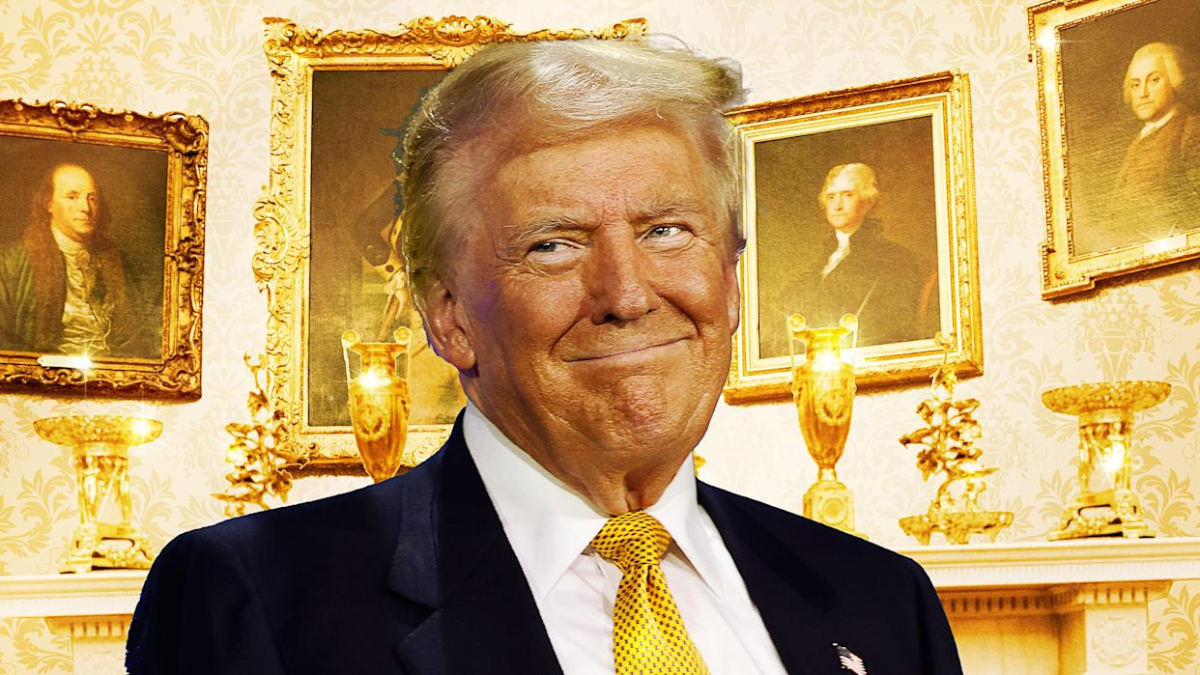Former President Donald Trump’s taste for extravagance is well-documented, from the gold-plated interiors of Trump Tower to the lavish aesthetics of his Mar-a-Lago estate.
Now, a newly revealed detail adds to that legacy — Trump reportedly requested that his official White House portrait feature a golden border so that it would “glimmer” under the light, according to New York Times reporter Maggie Haberman.
As is tradition, official portraits of U.S. presidents are commissioned after they leave office and are displayed in institutions like the White House and the National Portrait Gallery.
However, Trump, known for his hands-on approach to his personal image, reportedly took a more active role in the artistic direction of his own portrait — particularly in ensuring it would reflect the same opulence associated with his name.
Report Details Trump’s Involvement in the Portrait Design
Maggie Haberman, who has covered Trump extensively and authored a bestselling biography, recently reported that Trump directed that the border of his White House portrait be designed in gold, explicitly stating that it should “glimmer.”
While many presidents provide input or sit for portrait sessions, Trump’s desire to include shimmering gold framing appears to break from the more subdued tradition of presidential portraiture.
According to sources close to the matter, Trump reviewed several drafts of the portrait and insisted that the frame’s metallic tone be adjusted to shine in gallery lighting and photographs.
The former president reportedly felt that the portrait should reflect the “boldness” and “brightness” of his time in office — themes consistent with how he branded his administration and personal legacy.
This level of personal branding in presidential art is uncommon, but not entirely out of character for a president who reshaped political norms in more ways than one.
From gold-colored campaign hats to luxurious rally venues, Trump has frequently used aesthetics to reinforce his political messaging and brand.
Critics and Supporters Weigh In on Trump’s Artistic Decision
News of Trump’s golden border request drew mixed reactions across the political spectrum and online platforms. Critics described the choice as gaudy and “on-brand” in a way that trivializes the office of the presidency.
Political commentators pointed out that while former presidents often opt for dignified or minimalist portrait styles, Trump’s glimmering gold border feels more like a statement of personal luxury than public service.
“He’s turning what’s supposed to be a symbol of democratic leadership into a gilded billboard for himself,” one social media user commented.
However, Trump supporters viewed the decision more favorably. Some praised the former president for adding a personalized and memorable touch to the historical tradition. Others saw it as a reflection of his confidence, style, and refusal to conform to the status quo.
“Trump made the presidency his own, and the portrait should reflect that. The gold shows strength, prosperity, and success,” said one supporter on Truth Social.

Aesthetic Consistency with Trump’s Brand
Trump’s preference for gold isn’t new — it has been a consistent element in his personal brand for decades. His Manhattan penthouse is famously adorned with 24-karat gold fixtures, and his branded properties often feature gold accents on elevators, furnishings, and signage.
Even as president, Trump often leaned into the symbolism of gold. During his time in office, he used gold-framed mirrors and furniture in the Oval Office, carried a gold-colored Sharpie, and famously praised gold-plated military medals and awards.
These details all fed into a narrative of power, prestige, and visual grandeur.
According to branding experts, Trump’s insistence on a gold-bordered portrait fits his desire to create a legacy rooted in image and impact.
“Trump sees everything — including portraits — as an opportunity to reinforce who he is,” said marketing strategist Olivia Harper. “The gold border isn’t just a design choice; it’s a deliberate branding decision.”
Trump’s Presidential Portrait: Tradition Meets Modern Spectacle
Presidential portraits often reflect the personality and priorities of their subjects. George W. Bush’s portrait included a nod to his Texas roots.
Barack Obama’s famously modern painting symbolized hope and transformation. In contrast, Trump’s glimmering golden border represents his focus on luxury, showmanship, and personal branding.
Historians suggest the portrait may one day be viewed as a cultural time capsule — not just of the man himself, but of an era where politics, media, and celebrity blurred into one. Whether admired or criticized, the portrait has already succeeded in doing what Trump has long done best: commanding attention.
While the official unveiling of Trump’s White House portrait has not yet occurred publicly, it is expected to be housed alongside those of past presidents, including Joe Biden’s eventual portrait.
The gold-trimmed frame is likely to stand out among its more conservative counterparts, serving as a permanent reminder of the former president’s unique approach to leadership and legacy.
Conclusion: A Presidential Portrait That Reflects the Man
Donald Trump’s decision to adorn his official White House portrait with a glimmering golden border is more than just an aesthetic choice — it’s a continuation of the personal brand he has cultivated over decades in business and politics. It’s bold, flashy, and impossible to ignore — much like the man himself.
As presidential portraits are intended to preserve history for future generations, Trump’s golden frame may spark conversation for decades to come — about taste, tradition, and the image of American leadership in the 21st century.
You can read the original report at The New York Times.
Disclaimer – Our team has carefully fact-checked this article to make sure it’s accurate and free from any misinformation. We’re dedicated to keeping our content honest and reliable for our readers.
